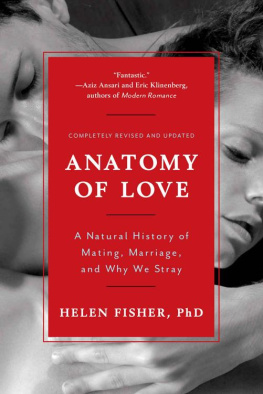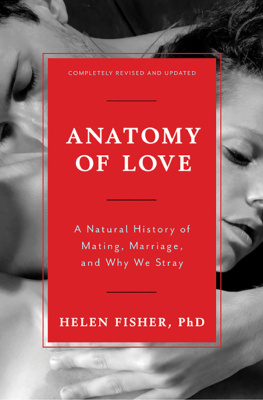Anatomy
of
Love
A Natural History of Mating,
Marriage, and Why We Stray
COMPLETELY REVISED AND UPDATED
Helen Fisher, PhD

W. W. Norton & Company
Independent Publishers Since 1923
New York London
FOR LOVERS EVERYWHERE
And in memory of Ray Carroll
CONTENTS
Journalist: Why do you only write about relationships?
Nora Ephron:Is there something else?
I was recently traveling in the highlands of New Guinea in the back of a pickup truck, talking with a man who had three wives. I asked him how many wives he would like to have. There was a pause as he rubbed his chin. I wondered: Would he say five? Ten? Twenty-five wives? He leaned toward me and whispered: None.
We are a pair-bonding species. Some 85% of cultures permit a man to have several wives, but few men actually build a harem. A man has to have a lot of goats, cows, land, money, or other impressive resources to get several women to share his wedding bed. Even then, having more than one wife can be a toothache. Co-wives fight; sometimes they even poison one anothers children. We are built to rear our babies as a team of twowith a lot of helpers near the nest.
This book is the story of that monumental human passion: to love. As well as all of the spinoffs of our basic human reproductive strategy: how we court; who we choose; how we bond; why some are adulterous and some divorce; how the drive to love evolved; why we have teenagers and vast networks of kin to rear our young; why a man cant be more like a woman and vice versa; how sex and romance drastically altered with the invention of the plow; and, in the last chapter, a new look at future sex.
When W. W. Norton invited me to do a second edition of this book, I gaily said yes, thinking this was a privilege and an easy job. The first version had taken me ten years to write; I thought this revision might take ten days. Then I read the bookand swiftly realized that I had to update almost all of it.
So I have now added a great deal of data and ideas, including data on all of our brain-scanning experiments on romantic love, rejection in love, and long-term love; my new data on the biology of personality and why you fall in love with one person rather than another; new information on adultery, love addiction, sexual selection, and mate choice; the newest statistics on worldwide patterns of divorce; my theory on the development of morality across the life course; my hypothesis about our modern dating habitswhat I call slow love,; and a wealth of new data on future sex, collected in collaboration with Match.com. I also added references for my additions (and retained most of the original references) and two of my questionnaires as additional appendices.
Journalist David Gergen once called me Americas last optimist. There is much to cry about, but there is also much to celebrateincluding our inexhaustible human drive to love. Technology is changing how we court. But it cant change love. Romantic love and attachment emanate from the most primitive regions of the brain, near those that orchestrate thirst and hunger. And as Plato aptly wrote in The Symposium: The God of love lives in a state of need. Love is a need, a craving, a drive to seek lifes greatest prize: a mating partner. We are born to love. Indeed, if we survive as a species, we will still fall in love and form pair-bonds a million years from now.
This book traces the trajectory of this indestructible human passion. And it ends on a high note. I firmly believe that if there ever was a time in human evolution when we have the opportunity to make happy partnerships, that time is now.
Heres to love,
Helen Fisher
ANATOMY OF LOVE
Moved by the force of love,
fragments of the world seek out one another
so that a world may be.
PIERRE TEILHARD DE CHARDIN
I n an apocryphal story, a colleague once turned to the great British geneticist J. B. S. Haldane and said, Tell me, Mr. Haldane, knowing what you do about nature, what can you tell me about God? Haldane replied, He has an inordinate fondness for beetles. Indeed, the world contains over 300,000 species of beetles.
I would add that God loves the human mating game, for no other aspect of our behavior is so complex, so subtle, or so pervasive. And although these sexual strategies differ from one individual to the next, the essential choreography of human courtship, romance, love, and marriage has myriad designs that seem etched into the human psyche, the product of time, selection, and evolution.
They begin the moment men and women get within courting rangewith the way we flirt.
Body Talk
Irenus Eibl-Eibesfeldt, a German ethologist,secret lens so that when he directed the camera straight ahead, he was actually taking pictures to the side. This way he could focus on local sights and catch on film the unstaged facial expressions of people near him. In his travels to Samoa, Papua, France, Japan, Africa, and Amazonia, he recorded numerous flirting sequences. Then, back in his laboratory at the Max Planck Institute for Behavioral Physiology, near Munich, Germany, he carefully examined each courting episode, frame by frame.
A universal pattern of female flirting emerged. Women from places as different as the jungles of Amazonia, the salons of Paris, and the highlands of New Guinea apparently flirt with the same sequence of expressions.
First, the woman smiles at her admirer and lifts her eyebrows in a swift, jerky motion as she opens her eyes wide to gaze at him. Then she drops her eyelids, tilts her head down and to the side, and looks away. Frequently she also covers her face with her hands, giggling nervously as she retreats behind her palms. This sequential flirting gesture is so distinctive that Eibl-Eibesfeldt is convinced it is innate, a human female courtship ploy that evolved eons ago to signal sexual and/or romantic interest.
Other gambits people use may also come from our primeval past. The coy look is a gesture in which a woman cocks her head and looks up shyly at her suitor. A female possum does this too, turning toward her suitor, cocking her snouty jaw, and looking straight into his eyes. Animals frequently toss their heads in order to solicit attention. Courting women do it regularly; they raise their shoulders, arch their backs, and toss their locks in a single sweeping motion. Albatrosses toss their heads and snap their bills between bouts of nodding, bowing, and rubbing bills together. Mud turtles extend and retract their heads, almost touching noses. Women are not the only creatures who use their heads to flirt.
Men also employ courting tactics similar to those seen in other species. Have you ever walked into the bosss office and seen him leaning back in his chair, hands clasped behind his head, elbows high, and chest thrust out? Perhaps he has come from behind his desk, walked up to you, smiled, arched his back, and thrust his upper body in your direction? If so, watch out. He may be subconsciously announcing his dominance over you. If you are a woman, he may be courting you instead.
The chest thrust is part of a basic postural message used across the animal kingdomstanding tall. Dominant creatures puff up. Codfish bulge their heads and thrust out their pelvic fins. Snakes, frogs, and toads inflate their bodies. Antelope and chameleons turn broadside to emphasize their bulk. Mule deer look askance to show their antlers. Cats bristle. Pigeons swell. Lobsters raise themselves onto the tips of their walking legs and extend their open claws. Gorillas pound their chests. Men just thrust out their chests.
When confronted by a more dominant animal, many creatures shrink. People turn in their toes, curl their shoulders, and hang their heads. Wolves tuck their tails between their legs and slink. Subordinate lobsters crouch. And many species bow. A bullied codfish curls its body downward. Lizards move their whole bodies up and down. Deferential chimpanzees nod their heads so rapidly and repeatedly that primatologists call it bobbing.
Next page







